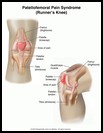
Runner's Knee: Teen Version
What is runner’s knee?
Runner’s knee is pain behind the kneecap. It may also be called patellofemoral disorder, patellar malalignment, patellofemoral pain syndrome, and chondromalacia.
How does it occur?
Runner’s knee can occur from overuse of the knee in sports and activities such as running, walking, jumping, or bicycling.
The kneecap (patella) is attached to the large group of muscles in the thigh called the quadriceps. It is also attached to the shin bone by the patellar tendon. The kneecap fits into grooves in the end of the thigh bone (femur) called the femoral condyle. With repeated bending and straightening of the knee, you can irritate the inside surface of the kneecap and cause pain.
Runner’s knee also may result from the way your hips, legs, knees, or feet are aligned. For example, if you have wide hips or underdeveloped thigh muscles, or if you are knock-kneed You may also have this problem if your foot flattens too much when you walk or run (a condition called over-pronation).
What are the symptoms?
The main symptom is pain behind the kneecap. You may have pain when you walk, run, or sit for a long time. The pain is usually worse when you walk downhill or down stairs. Your knee may swell at times. You may feel or hear snapping, popping, or grinding in the knee.
How is it diagnosed?
Your healthcare provider will review your symptoms and examine your knee. You will have knee X-rays. You may have an MRI to check for damage to the surface of the patella or femur or another injury.
How is it treated?
Treatment includes the following:
- Put an ice pack, gel pack, or package of frozen vegetables, wrapped in a cloth on the area every 3 to 4 hours, for up to 20 minutes at a time.
- Raise the knee on a pillow when you sit or lie down.
- Take an anti-inflammatory medicine such as ibuprofen, or other medicine as directed by your provider. Nonsteroidal anti-inflammatory medicines (NSAIDs) may cause stomach bleeding and other problems. These risks increase with age. Read the label and take as directed. Unless recommended by your healthcare provider, do not take for more than 10 days.
- Follow your provider’s instructions for doing exercises to help you recover. Your healthcare provider will show you exercises to help decrease the pain behind your kneecap.
- If you over-pronate, your healthcare provider may recommend shoe inserts, called orthotics. You can buy orthotics at a pharmacy or athletic shoe store or they can be custom-made.
- Use an infrapatellar strap, a strap placed below the kneecap over the patellar tendon.
- Wear a neoprene knee sleeve, which will give support to your knee and patella.
While you recover from your injury, you will need to change your sport or activity to one that does not make your condition worse. For example, you may need to bicycle or swim instead of run.
In cases of severe patellofemoral pain syndrome, surgery may be recommended.
How long will the effects last?
Pain behind the kneecap often lasts a long time and can come back after symptoms were better for a while. Treatment requires proper rehabilitation exercises that are done regularly.
When can I return to my normal activities?
Everyone recovers from an injury at a different rate. Return to your activities depends on how soon your knee recovers, not by how many days or weeks it has been since your injury has occurred. In general, the longer you have symptoms before you start treatment, the longer it will take to get better. The goal is to return you to your normal activities as soon as is safely possible. If you return too soon you may worsen your injury.
You may safely return to your normal activities when, starting from the top of the list and progressing to the end, each of the following is true:
- Your injured knee can be fully straightened and bent without pain.
- Your knee and leg have regained normal strength compared to the uninjured knee and leg.
- You are able to walk, bend, and squat without pain.
How can I prevent runner’s knee?
Runner’s knee can best be prevented by strengthening your thigh muscles, particularly the inside part of this muscle group. It is also important to wear shoes that fit well and that have good arch supports.

